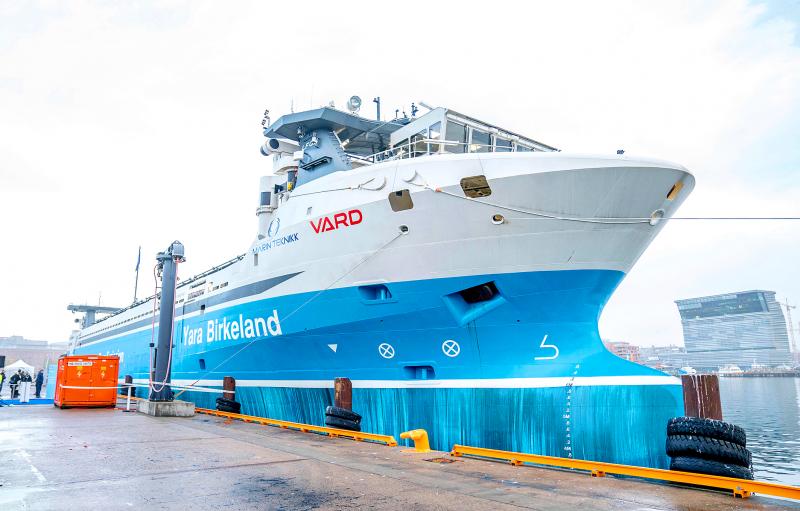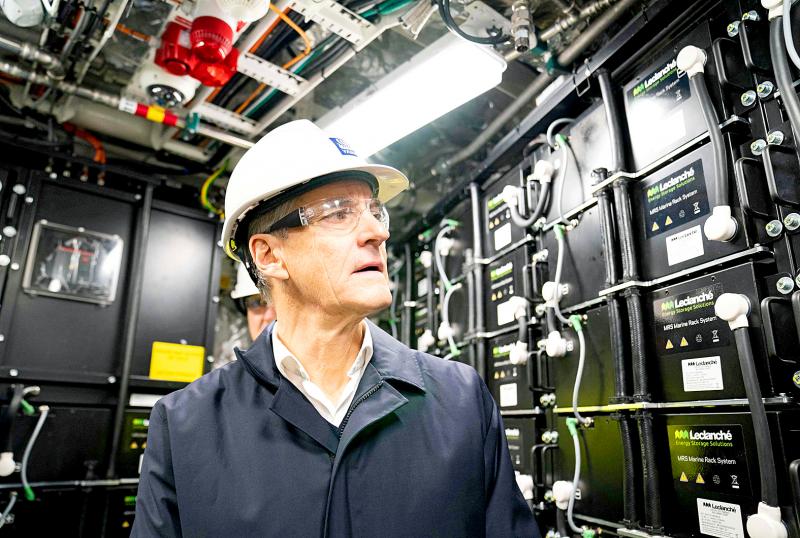Zero emissions and, soon, zero crew: The world’s first fully electric autonomous cargo vessel was unveiled in Norway, a small but promising step toward reducing the maritime industry’s climate footprint.
By shipping up to 120 containers of fertilizer from a plant in the southeastern town of Porsgrunn to Brevik’s port 12km away, the much-delayed Yara Birkeland, shown off to the media on Friday, would eliminate the need for about 40,000 truck journeys a year that are now fueled by polluting diesel.
“Of course, there have been difficulties and setbacks, but then it feels even more rewarding to stand here today in front this ship and see that we were able to do it,” said Svein Tore Holsether, chief executive of Norwegian fertilizer giant Yara International ASA, with the sleek blue-and-white vessel moored behind him in an Oslo dock, where it had been sailed for the event.

Photo: AFP
The 80m, 3,200 deadweight tonne ship is soon to begin two years of working trials, during which it would be fine-tuned to learn to maneuver on its own.
The wheelhouse could disappear altogether in “three, four or five years,” said Holsether, once the vessel makes its 7.5 nautical mile (13.89km) trips on its own with the aid of sensors.
“Quite a lot of the incidents happening on vessels are due to human error, because of fatigue for instance,” Yara International project manager Jostein Braaten said.

Photo: AFP
“Autonomous operating can enable a safe journey,” he added.
While the distance the Yara Birkeland would cover might be short, there would be many obstacles.
It would have to navigate in a narrow fjord, and sail under two bridges while managing currents and heavy traffic from merchant ships, pleasure craft and kayaks, before docking at one of Norway’s busiest ports.
The next few months are to be a learning period.
“First of all, we have to detect that there’s something there. We have to understand that it’s a kayak, then we have to determine what to do with that,” Braaten said.
“Currently, large vessels don’t do much with a kayak. They can’t do much. They can warn, but they cannot maneuver away” or reverse to avoid an incident, he said.
Autonomous navigation woud require a new set of regulations that do not exist yet.
On the Yara Birkeland, the traditional machine room has been replaced by eight battery compartments, giving the vessel a capacity of 6.8 megawatt hours (MWh) — sourced from renewable hydroelectricity.
“That’s the equivalent of 100 Teslas,” Braaten said.
The maritime sector, which is responsible for almost three percent of all man-made emissions, aims to reduce its emissions by 40 percent by 2030 and 50 percent by 2050.
Despite that, the sector has seen a rise in the past few years.
International and domestic shipping and fishing combined, the industry emitted more than 1 billion tonnes of greenhouse gases in 2018, up from 962 million tonnes in 2012, International Maritime Organization figures showed.
By itself, the Yara Birkeland’s contribution to global climate efforts would be just a drop in the ocean — eliminating 678 tonnes of carbon dioxide per year churned out by the redundant trucks.
Experts also do not expect electric vessels to become a universal solution for the industry any time soon.
“Electricity has a ‘niche’ use, in particular for ferries as these are often short and stable routes, possibly on coastal and river transports, but it’s not well-adapted for long ocean crossings,” said Camille Egloff, a maritime transport expert at Boston Consulting Group.
“Not only would [a vessel] need to be autonomous for long distances, but you would also have to equip ports with battery chargers, so there are technical and infrastructure challenges that would need to be coordinated,” she said.
While dozens of electric ferries already criss-cross the fjords of Norway — a major oil and gas producer which is paradoxically also a leader in electric transport — ocean liners would have to rely on other technologies to go green, such as liquified natural gas, e-methanol and hydrogen.

The US dollar was trading at NT$29.7 at 10am today on the Taipei Foreign Exchange, as the New Taiwan dollar gained NT$1.364 from the previous close last week. The NT dollar continued to rise today, after surging 3.07 percent on Friday. After opening at NT$30.91, the NT dollar gained more than NT$1 in just 15 minutes, briefly passing the NT$30 mark. Before the US Department of the Treasury's semi-annual currency report came out, expectations that the NT dollar would keep rising were already building. The NT dollar on Friday closed at NT$31.064, up by NT$0.953 — a 3.07 percent single-day gain. Today,

‘SHORT TERM’: The local currency would likely remain strong in the near term, driven by anticipated US trade pressure, capital inflows and expectations of a US Fed rate cut The US dollar is expected to fall below NT$30 in the near term, as traders anticipate increased pressure from Washington for Taiwan to allow the New Taiwan dollar to appreciate, Cathay United Bank (國泰世華銀行) chief economist Lin Chi-chao (林啟超) said. Following a sharp drop in the greenback against the NT dollar on Friday, Lin told the Central News Agency that the local currency is likely to remain strong in the short term, driven in part by market psychology surrounding anticipated US policy pressure. On Friday, the US dollar fell NT$0.953, or 3.07 percent, closing at NT$31.064 — its lowest level since Jan.

The New Taiwan dollar and Taiwanese stocks surged on signs that trade tensions between the world’s top two economies might start easing and as US tech earnings boosted the outlook of the nation’s semiconductor exports. The NT dollar strengthened as much as 3.8 percent versus the US dollar to 30.815, the biggest intraday gain since January 2011, closing at NT$31.064. The benchmark TAIEX jumped 2.73 percent to outperform the region’s equity gauges. Outlook for global trade improved after China said it is assessing possible trade talks with the US, providing a boost for the nation’s currency and shares. As the NT dollar

The Financial Supervisory Commission (FSC) yesterday met with some of the nation’s largest insurance companies as a skyrocketing New Taiwan dollar piles pressure on their hundreds of billions of dollars in US bond investments. The commission has asked some life insurance firms, among the biggest Asian holders of US debt, to discuss how the rapidly strengthening NT dollar has impacted their operations, people familiar with the matter said. The meeting took place as the NT dollar jumped as much as 5 percent yesterday, its biggest intraday gain in more than three decades. The local currency surged as exporters rushed to